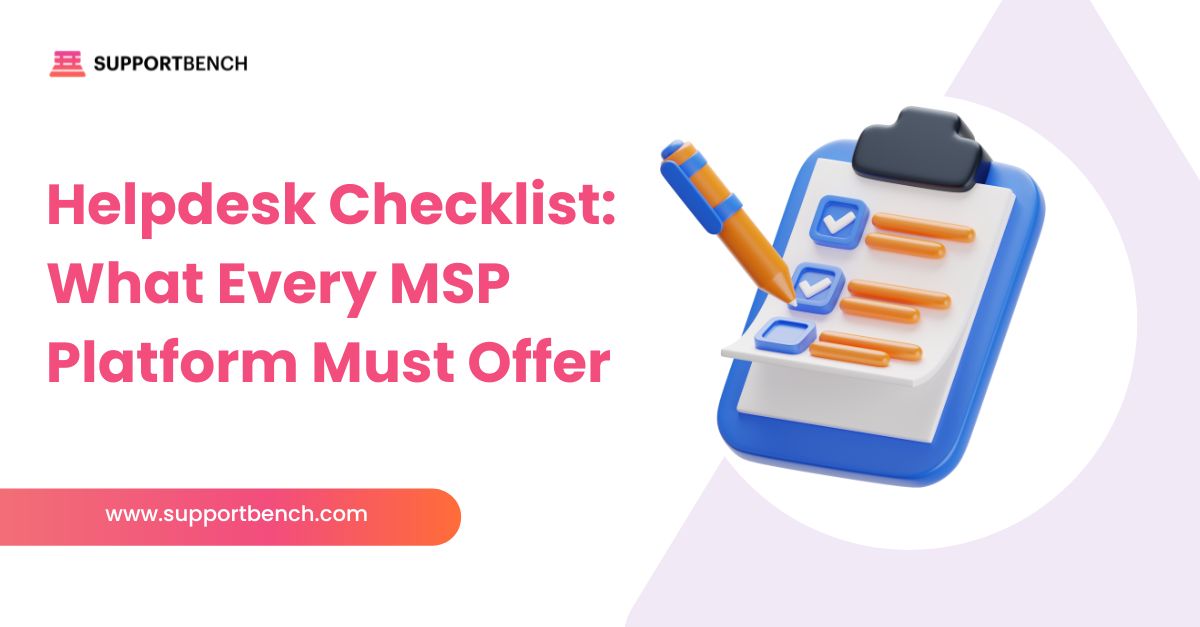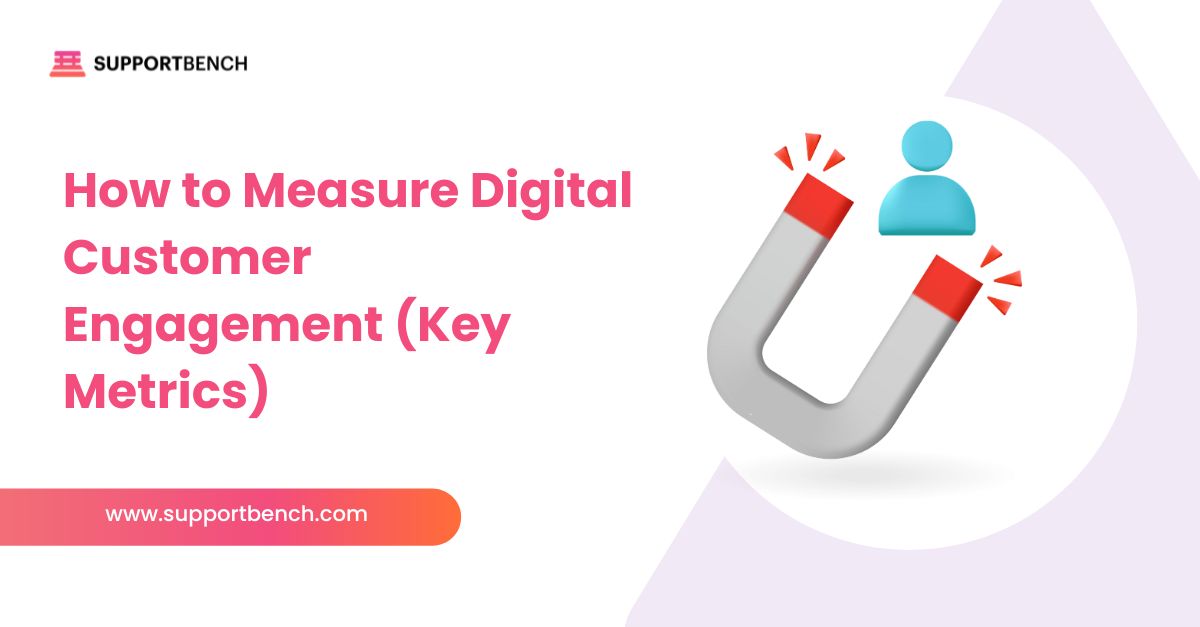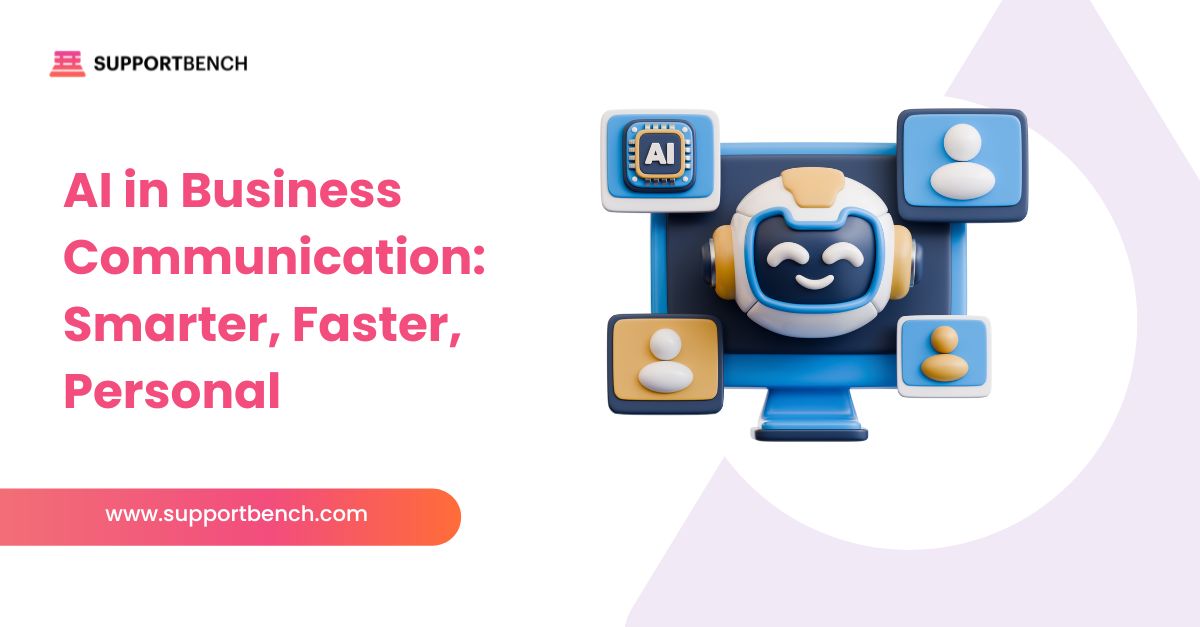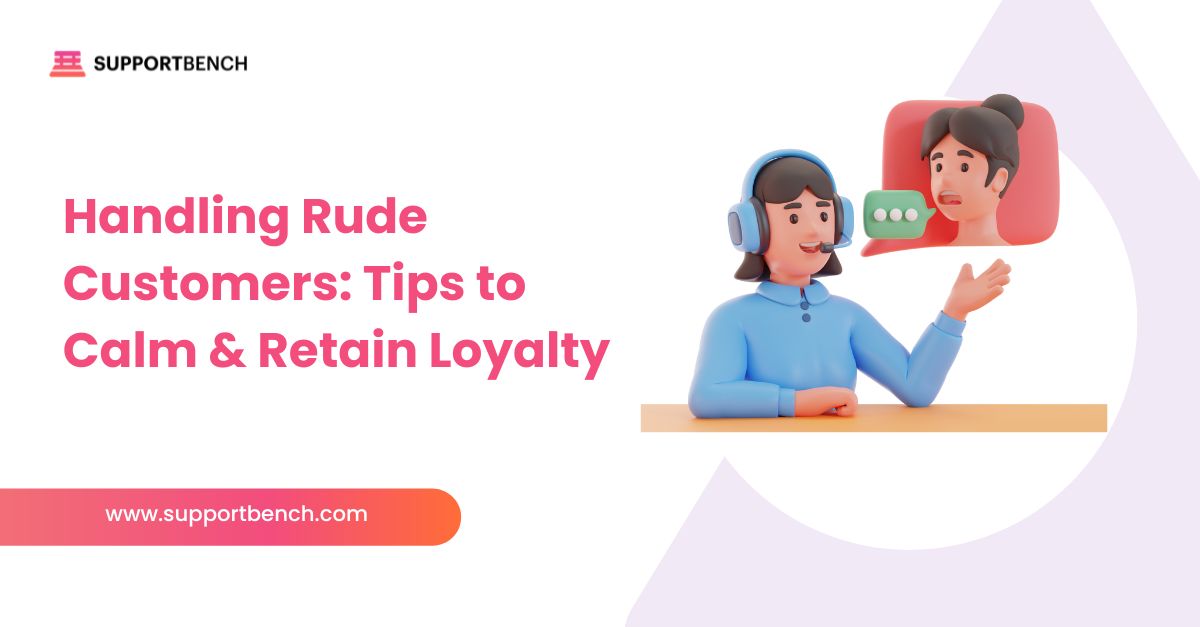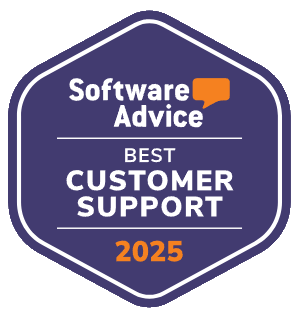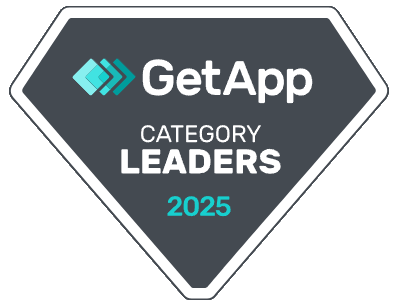For managed service providers (MSPs), the helpdesk is more than a support inbox. It’s the operational backbone for delivering reliable, measurable service across multiple clients.
As client expectations rise and service environments grow more complex, relying on outdated or generic tools creates friction. Missed SLAs, inconsistent workflows, and disconnected data can damage trust and slow down teams.
Choosing the right helpdesk software isn’t just a technical upgrade. It’s a strategic move.
Modern MSPs need platforms that support structured workflows, enforce SLAs, surface actionable insights, and scale alongside their business.
This checklist highlights the must-have capabilities every MSP helpdesk should include, and shows how solutions like Supportbench are designed to meet those needs from day one.

At a Glance:
MSPs need helpdesk software with SLA enforcement, AI-powered ticket summaries, automation rules, real-time reporting, client-facing dashboards, and secure multi-tenant portals. Supportbench delivers all 10 must-have features in a single scalable platform built for MSP workflows.
1. Ticket Management & Workflow Capabilities
At the heart of every helpdesk is the ticketing system. For MSPs, it needs to go beyond basic issue logging and support organized, multi-channel, and automated workflows.
Multi-Channel Ticket Ingestion
The system should pull in tickets from email, chat, web forms, phone, and even social channels, centralizing everything into a unified inbox. Agents can manage requests without toggling between platforms.
Custom Fields, Categories, and Workflows
Different clients have different priorities. Your helpdesk must allow flexible categorization, custom fields, and workflow automation, so tickets are routed, tagged, or escalated based on rules that reflect real-world contracts.
Sub-Tasks and Technician Tracking
Tickets should support sub-tasks, internal logs, and technician time tracking. This improves handoffs, sets clearer expectations, and ensures accountability throughout the resolution process.
➤ Supportbench offers all of these capabilities with intuitive configuration, making it easier for MSP teams to stay organized, move faster, and deliver consistently across clients.

2. ITSM Functionality Beyond Ticketing
MSPs do more than answer support tickets. They manage complex service delivery across infrastructure, software, and people. That’s where integrated ITSM features become essential.
Incident, Problem, Change, and Asset Modules
Look for built-in modules to manage incidents, track recurring problems, log asset details, and document change approvals. These tools keep service records organized and provide full visibility into recurring issues or device-level history.
Contract and License Management
A complete helpdesk should track software licenses, hardware warranties, and service contracts. This ensures technicians always have the context needed to resolve issues and adds value beyond reactive support.
Integration with PSA or RMM Tools
To avoid tool sprawl, your helpdesk should either include built-in PSA/RMM functionality or integrate smoothly with third-party systems. API access is critical for syncing data across tools without duplicating work.
➤ Supportbench supports all of the above, either natively or through secure, real-time integrations, so MSPs can streamline service processes and centralize operations in one platform.

3. Self‑Service and Knowledge Base
Reducing ticket volume starts by empowering clients to solve common issues on their own. A strong self-service system improves efficiency for both users and agents.
Client Self-Service Portal
Your helpdesk should include a secure, branded portal where clients can submit tickets, check status, and browse help articles. This reduces low-priority requests and improves transparency.
Auto-Suggested Knowledge Base Articles
When a client begins typing a ticket subject or description, the system should automatically suggest relevant KB articles or pre-written macros. This deflects common tickets and speeds up first-contact resolution.
Easy Article Creation and Management
Agents need to create and update knowledge base entries without jumping between tools. In-ticket article suggestions, tagging, and linking should be built into the agent workflow.
➤ Supportbench makes this seamless with inline KB editing, suggested content during ticket creation, and portal access tailored to each client.

4. Automation, AI, and Sentiment Capabilities
Managing tickets manually doesn’t scale. Modern MSPs need automation to handle routine tasks and AI to enhance response quality and identify client sentiment before it becomes a problem.
Automation Rules and Triggers
Look for software that allows you to automate common actions, like assigning tickets, escalating based on priority, tagging by keyword, or auto-closing inactive threads. These rules reduce repetitive work and ensure faster routing.
AI Assistance for Resolution
AI tools should help agents, not replace them. Features like ticket summarization, draft replies, or automated KB article generation increase consistency while saving time.
Supportbench’s AI Co-Pilot, for example, generates summaries and builds articles based on ticket content, reducing agent workload and improving accuracy.
Sentiment Analysis and Predictive Metrics
Understanding how clients feel is just as important as what they say. Sentiment tracking helps flag frustration early, while predictive CES scoring highlights tickets at risk of poor satisfaction.
➤ Supportbench turns tone into actionable insight, giving your team a head start on escalation and coaching opportunities.

5. Service Level Agreements and Performance Monitoring
SLAs are the foundation of trust between MSPs and their clients. Your helpdesk platform should help you track, manage, and enforce SLAs, while giving leadership the data to monitor overall performance.
Dynamic SLA Configuration
You should be able to define SLA rules per client, contract, or ticket type. This includes setting response/resolution targets, alerts for upcoming breaches, and automatic escalations when time thresholds are missed.
Dashboards and Analytics
A strong platform offers real-time visibility into ticket volume, backlog, agent workloads, and SLA compliance. Look for visual dashboards with drill-downs by client, priority, or issue type.
Predictive Customer Satisfaction Tools
Some platforms can now forecast ticket sentiment before it’s too late. Supportbench includes predictive CES scoring, letting you intervene early when a client’s satisfaction is at risk.
Real-Time Oversight
Dashboards should update continuously, giving managers the insights needed to react quickly, coach agents, and maintain service consistency.
➤ Supportbench delivers all of the above, so your team stays ahead of SLA issues, not behind them.

6. Security, Compliance, and Data Protection
Your clients trust you with sensitive data. That trust depends on choosing helpdesk software that prioritizes data security, access control, and compliance.
Role-Based Access Controls (RBAC)
Agents should only access the data relevant to their roles. Clients using white-labelled portals must see only their own tickets, documents, and status updates.
Encryption and Audit Trails
All communication and ticket data should be encrypted, both in transit and at rest. The system should maintain audit logs that capture ticket edits, agent actions, and access events.
Compliance-Ready Features
If your clients operate in regulated industries (e.g. healthcare, finance, legal), your helpdesk software must support compliance standards like GDPR, HIPAA, or SOC 2.
➤ Supportbench includes encrypted data handling, customizable access roles, and comprehensive logging, so MSPs can stay compliant and build long-term client confidence.

7. Integration, Customization & Scalability
A helpdesk platform should grow with your MSP, not limit it. That means seamless integrations, flexible configuration, and support for diverse client environments.
Native and API-Based Integrations
Your helpdesk should connect easily with core platforms like CRMs, RMM tools, and billing systems. Whether through native connectors or REST APIs, data should flow between systems without manual entry.
Supportbench offers both types, supporting real-time integration with tools your team already relies on.
Custom Dashboards and Data Views
Different clients and teams may need different reporting views. Look for platforms that allow custom data tables, filters, and exportable reports per brand, client, or contract.
Scalable Architecture
As your MSP adds clients, services, or regions, the helpdesk must support that growth. This includes multi-brand setups, team-based routing, and performance at scale, without requiring constant vendor support.
➤ Supportbench is built for scale, allowing MSPs to evolve from startup to enterprise without changing platforms or piling on third-party tools.

8. Onboarding, Training, and User Experience
Even the most powerful helpdesk is only effective if your team can use it efficiently. Look for platforms that support fast onboarding and a clean, intuitive interface for both agents and clients.
Agent Training and Support Resources
The platform should offer onboarding guides, tutorials, in-app prompts, or direct support to help teams get up to speed. This reduces the ramp-up time for new hires and accelerates ROI.
User-Friendly Interface
A cluttered UI slows agents down. Your helpdesk should have a clean layout, easy-to-use navigation, and accessible ticket views. Supportbench is frequently praised for its agent-first design and responsive support, even by teams with limited technical resources.
Multi-Brand Portals and UI Customization
For MSPs managing multiple clients, the ability to white-label portals and tailor views per brand or organization is essential. Each client should feel like they’re using a system made for them.
➤ Supportbench combines ease of use with the flexibility to serve multiple clients, without sacrificing speed, clarity, or control.

9. Feedback Loop and Continuous Improvement
Great support isn’t static. Your helpdesk should help you collect feedback, identify trends, and continuously improve service quality across clients.
Automated Client Feedback Collection
CSAT, CES, or custom feedback forms should be sent automatically after ticket closure. The system should allow segmentation by client, issue type, or priority, so you can identify where to improve.
Agent-Level Sentiment and Coaching Data
Sentiment tracking by agent helps pinpoint who needs support and who’s excelling. This enables targeted coaching, recognition, and skill development.
Performance Trend Reviews
Recurring issues, delayed responses, or negative trends should surface in regular reviews. Your platform should help you spot these patterns, and make it easy to update workflows, response templates, or KB articles accordingly.
➤ Supportbench makes this process seamless with built-in sentiment tracking, ticket surveys, and real-time dashboards that highlight coaching opportunities and recurring service gaps.

10. Reporting, Client Transparency & ROI Measurement
Your helpdesk should do more than track tickets. It should prove your value. Clear reporting builds trust, drives retention, and helps MSPs measure impact over time.
Detailed, Exportable Reporting
Look for customizable reports that can be filtered by client, contract, or service type. Exportable formats are essential for internal reviews and client-facing reporting.
Client Dashboards
Transparency strengthens relationships. Giving clients real-time access to ticket status, SLA metrics, and service summaries helps reinforce accountability and demonstrate ongoing value.
ROI and Impact Tracking
Platforms should help you measure operational gains, like reduced ticket volume, faster resolution times, improved client satisfaction, or decreased support costs. These insights justify the investment and guide resource planning.
➤ Supportbench offers both internal and client-level reporting tools, with dashboards designed to track performance, reveal trends, and support strong client communication.
Sample MSP Helpdesk Requirements Checklist Table
Use this quick-reference list to evaluate vendors during your selection process. Each category reflects a key area of functionality every MSP should prioritize.
✅ Ticket Management
- Unified inbox for all support channels
- Custom workflows and ticket fields
- Technician task tracking and internal logs
Why it matters: Keeps handling consistent and ensures timely resolution.
✅ ITSM Modules
- Incident, problem, change, and asset management
- License and contract tracking
- PSA and RMM integrations
Why it matters: Supports more complex service operations and streamlines ecosystem connectivity.
✅ Self-Service & Knowledge Base
- Branded client portal with ticket logging and tracking
- Auto-suggested KB content during ticket entry
- Easy article creation from the agent view
Why it matters: Reduces Level-1 ticket volume and improves client independence.
✅ Automation & AI
- Trigger-based automation for routing, tagging, escalation
- AI-generated summaries and KB articles
- Sentiment tracking and predictive scoring
Why it matters: Boosts efficiency and helps catch problems early.
✅ SLA Management & Analytics
- Dynamic SLAs per client or contract
- Dashboards for volume, resolution time, SLA breaches
- Predictive CES tools and real-time updates
Why it matters: Helps enforce service commitments and improve delivery.
✅ Security & Access Control
- Role-based access and audit logs
- Encryption at rest and in transit
- Compliance support (GDPR, HIPAA, SOC 2)
Why it matters: Protects client data and supports regulated industries.
✅ Integrations & Scalability
- Native connectors and flexible APIs
- Custom dashboards per brand or client
- Multi-tenant and multi-brand support
Why it matters: Enables growth and adapts to diverse client structures.
✅ Training & User Experience
- Agent onboarding tools and tutorials
- Intuitive interface with low learning curve
- White-labelled portals for each client
Why it matters: Accelerates adoption and supports long-term usage.
✅ Feedback & Service Improvement
- Post-ticket CSAT/CES surveys
- Agent-level sentiment tracking
- Insights into recurring issues or bottlenecks
Why it matters: Drives ongoing optimization and staff development.
✅ Reporting & ROI Measurement
- Exportable internal and client-facing reports
- Visual client dashboards for transparency
- Metrics that show cost reduction or satisfaction gains
Why it matters: Builds trust and proves the value of your service.
Implementation Strategy: How to Use the Checklist
A checklist is only valuable if it leads to real-world improvements. Here’s how MSPs can turn planning into action:
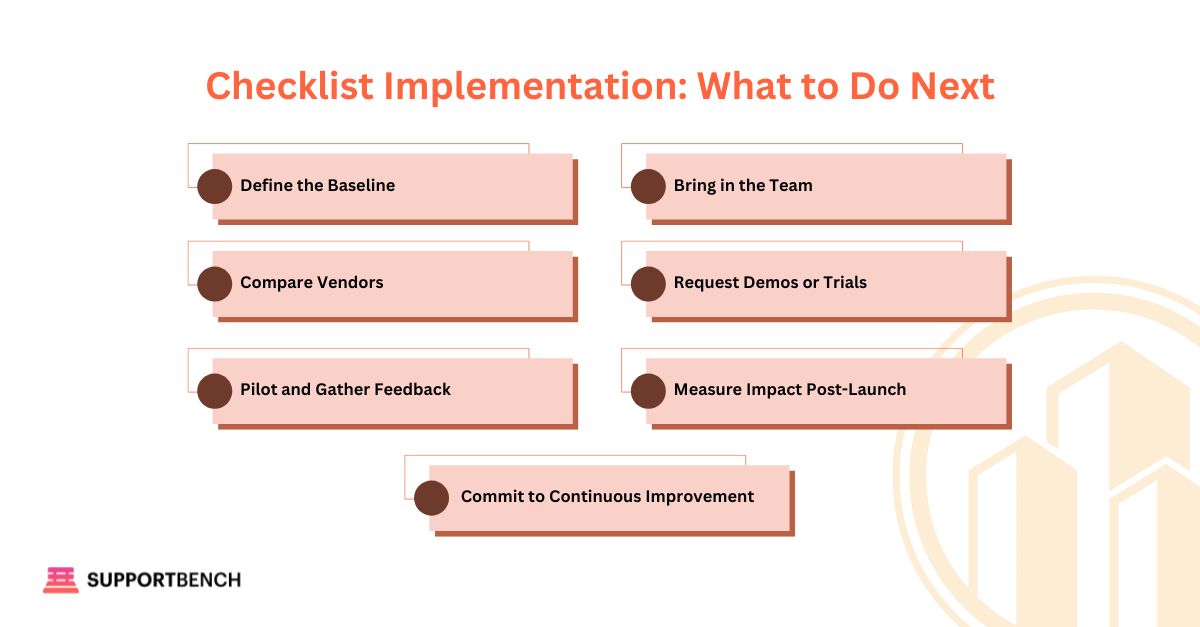
1. Define Your Baseline
Start by assessing your current tools and workflows. Identify gaps in SLA tracking, automation, reporting, or ticket management. Score your existing system against each requirement in the checklist.
2. Involve the Right People
Bring in stakeholders from support, operations, and client services. Use their input to prioritize features based on real pain points, not just perceived needs.
3. Compare Vendors Side by Side
Evaluate platforms like Supportbench against each checklist category. Assign weighted scores to features that matter most for your clients and internal teams.
4. Request Demos or Trials
Ask vendors to demonstrate key use cases:
- Multi-channel intake
- SLA and escalation workflows
- Knowledge base creation
- Sentiment analysis
- Integration with PSA/RMM systems
Use these demos to validate capabilities, not just promises.
5. Run a Pilot and Collect Feedback
Select a small agent group or subset of clients for a short-term trial. Evaluate usability, speed, automation quality, and reporting clarity. Gather honest feedback before committing.
6. Measure Post-Launch Impact
After deployment, compare your new metrics against your baseline. Look at ticket volume, resolution times, SLA compliance, and customer satisfaction to assess progress.
7. Commit to Ongoing Refinement
Use built-in surveys, agent sentiment tracking, and dashboard trends to iterate. Update KB articles, fine-tune automation rules, and coach teams based on data—not gut feel.
Supportbench supports every stage of this process, from trial to rollout, with flexible tools, actionable insights, and responsive onboarding support.
Why Supportbench Aligns with This Checklist
Supportbench was built to meet the real-world needs of MSPs, not just general IT support teams. Here’s how it matches the checklist from top to bottom:
✅ Unified, All-in-One Platform
Supportbench combines ticketing, knowledge base, SLA tracking, automation, sentiment analysis, and reporting in one seamless environment—no need to stitch together separate tools.
✅ Built-In AI That Works for Agents
From summarizing tickets to drafting KB articles, Supportbench’s AI Co-Pilot helps agents work faster while maintaining quality. It’s designed to reduce workload, not add complexity.
✅ Advanced SLA Tools
Create dynamic, contract-specific SLAs with customizable timers, scorecards, and real-time escalation alerts. SLAs are enforced automatically, not bolted on as an afterthought.
✅ Predictive Insights and Sentiment Tracking
Monitor CES scores and client tone at scale. Spot dissatisfaction early and take action before issues escalate.
✅ Multi-Brand, Multi-Tenant Design
Supportbench allows complete separation of clients and brands, with white-labeled portals, custom dashboards, and role-based permissions across all accounts.
✅ Scalable Integrations
The platform connects natively to CRMs, RMMs, and billing platforms, or integrates via open API, so your tech stack grows with you, not against you.
✅ Rapid Onboarding and Proven Support
From intuitive UI to hands-on implementation help, Supportbench is known for responsive customer support and smooth onboarding, even for smaller teams or fast-growing MSPs.
From replacing a patchwork of tools to upgrading from a general-purpose solution, Supportbench aligns with the exact features modern MSPs need to scale efficiently and deliver consistent, high-trust service.
Conclusion
Choosing the right helpdesk software is a strategic decision for every MSP. It’s not just about features. It’s about finding a platform that supports operational scale, meets client expectations, and adapts as your services evolve.
This checklist highlights the 10 core capabilities every MSP helpdesk should include, from SLA enforcement and automation to sentiment tracking, reporting, and multi-tenant flexibility.
Supportbench checks every box.
It offers a unified platform with built-in AI, customizable workflows, predictive insights, and white-labelled portals—designed to help MSPs streamline support, scale efficiently, and build lasting client trust.
Use this checklist to guide vendor comparisons, test shortlisted platforms, and make a confident, data-driven choice.
Time to see how Supportbench fits your team!
Book a demo today and experience how a purpose-built helpdesk can power your MSP’s next phase of growth.


